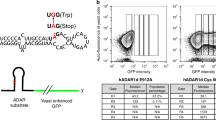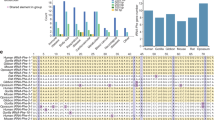Abstract
RNA editing by site-selective deamination of adenosine to inosine1,2 alters codons3,4 and splicing5 in nuclear transcripts6, and therefore protein function. ADAR2 (refs 7, 8) is a candidate mammalian editing enzyme that is widely expressed in brain and other tissues7, but its RNA substrates are unknown. Here we have studied ADAR2-mediated RNA editing by generating mice that are homozygous for a targeted functional null allele. Editing in ADAR2-/- mice was substantially reduced at most of 25 positions in diverse transcripts3,4,5,6; the mutant mice became prone to seizures and died young. The impaired phenotype appeared to result entirely from a single underedited position, as it reverted to normal when both alleles for the underedited transcript were substituted with alleles encoding the edited version exonically9. The critical position specifies an ion channel determinant10, the Q/R site3,6, in AMPA (α-amino-3-hydroxy-5-methyl-4-isoxazole propionate) receptor10 GluR-B pre-messenger RNA. We conclude that this transcript is the physiologically most important substrate of ADAR2.
This is a preview of subscription content, access via your institution
Access options
Subscribe to this journal
Receive 51 print issues and online access
$199.00 per year
only $3.90 per issue
Buy this article
- Purchase on SpringerLink
- Instant access to full article PDF
Prices may be subject to local taxes which are calculated during checkout




Similar content being viewed by others
References
Bass, B. L. RNA editing. An I for editing. Curr. Biol. 5, 598–600 (1995).
Rueter, S. & Emeson, R. in Modification and Editing of RNA (eds Grosjean, H. & Benne, R.) 343–361 (ASM, Washington DC, 1998).
Seeburg, P. H., Higuchi, M. & Sprengel, R. RNA editing of brain glutamate receptor channels: mechanism and physiology. Brain Res. Rev. 26, 217– 229 (1998).
Burns, C. M. et al. Regulation of serotonin-2C receptor G-protein coupling by RNA editing. Nature 387, 303– 308 (1997).
Rueter, S. M., Dawson, T. R. & Emeson, R. B. Regulation of alternative splicing by RNA editing. Nature 399, 75–79 (1999).
Higuchi, M. et al. RNA editing of AMPA receptor subunit GluR-B: A base-paired intron–exon structure determines position and efficiency. Cell 75, 1361–1370 ( 1993).
Melcher, T. et al. A mammalian RNA editing enzyme. Nature 379, 460–464 (1996).
Bass, B. L. et al. A standardized nomenclature for adenosine deaminases that act on RNA. RNA 3, 947– 949 (1997).
Kask, K. et al. The AMPA receptor subunit GluR-B in its Q/R site-unedited form is not essential for brain development and function. Proc. Natl Acad. Sci. USA 95, 13777–13782 (1998).
Dingledine, R., Borges, K., Bowie, D. & Traynelis, S. F. The glutamate receptor ion channels. Pharmacol. Rev. 51, 7–61 (1999).
Brusa, R. et al. Early-onset epilepsy and postnatal lethality associated with an editing-deficient GluR-B allele in mice. Science 270, 1677–1680 (1995).
Feldmeyer, D. et al. Neurological dysfunctions in mice expressing different levels of the Q/R site-unedited AMPAR subunit GluR-B. Nature Neurosci. 2, 57–64 (1999 ).
Melcher, T. et al. RED2, a brain-specific member of the RNA-specific adenosine deaminase family. J. Biol. Chem. 271, 31795 –31798 (1996).
Maas, S. et al. Different structural and enzymatic requirements for RNA editing in glutamate receptor pre-mRNAs. J. Biol. Chem. 271 , 12221–12226 (1996).
Lai, F., Chen, C. X., Carter, K. C. & Nishikura, K. Editing of glutamate receptor B subunit ion channel RNAs by four alternatively spliced DRADA2 double-stranded RNA adenosine deaminases. Mol. Cell. Biol. 17, 2413–2424 ( 1997).
Villard, L., Tassone, F., Haymowicz, M., Welborn, R. & Gardiner, K. Map location, genomic organization and expression patterns of the human RED1 RNA editase. Somat. Cell. Mol. Gen. 23, 135–145 ( 1997).
Nagy, A., Rossant, J., Nagy, R., Abramow-Newerly, W. & Roder, J. C. Derivation of completely cell culture-derived mice from early-passage embryonic stem cells. Proc. Natl Acad. Sci. USA 90, 8424–8428 ( 1993).
Dabiri, G. A., Lai, F., Drakas, R. A. & Nishikura, K. Editing of GluR-B ion channel RNA in vitro by recombinant double-stranded RNA adenosine deaminase. EMBO J. 15, 34–45 (1996).
Zamanillo, D. et al. Importance of AMPA receptors for hippocampal synaptic plasticity but not for spatial learning. Science 284, 1805–1811 (1999).
Jia, Z. et al. Enhanced LTP in mice deficient in the AMPA receptor GluR2. Neuron 17, 945–956 ( 1996).
Herb, A., Higuchi, M., Sprengel, R. & Seeburg, P. H. Q/R site editing in kainate receptor GluR5 and GluR6 pre-mRNAs requires distant intronic sequences. Proc. Natl Acad. Sci. USA 93, 1875–880 (1996).
Reenan, R. A., Hanrahan, C. J. & Ganetzky, B. The mlenapts RNA helicase mutation in Drosophila results in a splicing catastrophe of the para Na+ channel transcript in a region of RNA editing. Neuron 25, 139–149 (2000).
Geiger, J. R. P. et al. Relative abundance of subunit mRNAs determinates gating and Ca2+ permeability of AMPA receptors in principal neurons and interneurons in rat CNS. Neuron 15, 193– 204 (1995).
Wisden, W. & Morris, B. J. in In Situ Protocols for the Brain (eds Wisden, W. & Morris, B. J. 9–30 (Academic, London, 1994).
Wang, Y., Zeng, Y., Murray, J. M. & Nishikura, K. Genomic organization and chromosomal localization of the human dsRNA adenosine deaminase gene: the enzyme for glutamate-activated ion channel RNA editing. J. Mol. Biol. 254, 184–195 (1995).
Köhler, M., Kornau, H. -C. & Seeburg, P. H. The gene for the principal AMPA receptor subunit GluR-B: organization and sequences for alternatively spliced and edited transcripts. J. Biol. Chem. 269, 17367– 17370 (1994).
Lomeli, H. et al. Control of kinetic properties of AMPA receptor channels by nuclear RNA editing. Science 266, 1709– 1713 (1994).
Acknowledgements
We thank R. Wenthold for the antibody to GluR-B; A. Nagy for the murine embryonic stem cell line R1; K. Kask for help with GluR-BR mice; F. Zimmermann for blastocyst injection; S. Grünewald and H. Grosskurth for DNA sequencing; U. Amtmann for in situ hybridization; and H. Avci, C. Faul and C. Baust for technical help. This work was supported, in part, by the Deutsche Forschungsgemeinschaft, the Human Frontier Science Program and the Bristol-Myers Squibb foundation.
Author information
Authors and Affiliations
Corresponding author
Rights and permissions
About this article
Cite this article
Higuchi, M., Maas, S., Single, F. et al. Point mutation in an AMPA receptor gene rescues lethality in mice deficient in the RNA-editing enzyme ADAR2. Nature 406, 78–81 (2000). https://doi.org/10.1038/35017558
Received:
Accepted:
Issue Date:
DOI: https://doi.org/10.1038/35017558
This article is cited by
-
FLI1 is associated with regulation of DNA methylation and megakaryocytic differentiation in FPDMM caused by a RUNX1 transactivation domain mutation
Scientific Reports (2024)
-
Deep transcriptome profiling reveals limited conservation of A-to-I RNA editing in Xenopus
BMC Biology (2023)
-
The Q/R editing site of AMPA receptor GluA2 subunit acts as an epigenetic switch regulating dendritic spines, neurodegeneration and cognitive deficits in Alzheimer’s disease
Molecular Neurodegeneration (2023)
-
Biological roles of A-to-I editing: implications in innate immunity, cell death, and cancer immunotherapy
Journal of Experimental & Clinical Cancer Research (2023)
-
RNA modification: mechanisms and therapeutic targets
Molecular Biomedicine (2023)



